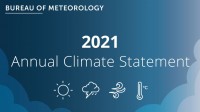2021 coolest year in nearly a decade and wettest since 2016
06/01/2022

2021 was Australia's coolest year in nearly a decade, according to the Bureau of Meteorology’s Annual Climate Statement, released today.
By the end of 2021 - and for the first time in five years - no large parts of the country were experiencing rainfall deficits and drought conditions.
The Statement is the official summary and contextual information regarding temperatures, rainfall and significant weather for the 2021 calendar year.
Bureau of Meteorology Senior Climatologist Dr Simon Grainger said: "After three years of drought from 2017 to 2019, above average rainfall last year resulted in a welcome recharge of our water storages but also some significant flooding to eastern Australia."
In 2021, Australia's mean temperature was 0.56 °C above the 1961 to 1990 climate reference period. It was the 19th warmest year since national records began in 1910, but also the coolest year since 2012.
Despite the cooling impacts of the negative Indian Ocean Dipole, a period of warmer than usual ocean temperatures in the western Indian ocean, and La Niña, a period of cooling of the central and eastern tropical Pacific Ocean, 2021 was warmer than average (calculated in relation to the 1961 to 1990 climate reference period) and warmer than historical La Niña years.
Temperatures were above or very much above average for most of northern Australia, Tasmania, and Western Australia's west coast, but below average for parts of inland New South Wales, and around the southern border of the Northern Territory and Western Australia.
Rainfall was 9 per cent above the 1961 to 1990 average, making 2021 the wettest year since 2016, with November the wettest on record.
Above average rainfall was observed for much of eastern Victoria, New South Wales, southern and central west Queensland, the western parts of Western Australia, and large parts of the far northern tropics.
As a result, significant flooding occurred across eastern Australia in March and again in November and December
On a positive note, the major dams in the Murray Darling Basin saw significant increases of water levels, replenishing storages affected by protracted drought.
Only a few small areas saw below average rainfall, including the border region of South Australia and Victoria.
A full report on Australia's weather and climate of 2021 will be released in February.
Stay up to date with 2022 climate as it happens, with our weekly, monthly and seasonal climate outlooks, updated on our website: http://www.bom.gov.au/climate/outlooks/
Keep up to date with the latest forecasts via the Bureau’s website at www.bom.gov.au and via the BOM Weather app.
Audio grabs
Please find audio grabs from Senior Climatologist Dr Simon Grainger below, including high-level overviews of each region's climate-related headlines from 2021.
National grabs here.
Qld grabs here.
NSW grabs here.
Vic grabs here.
Tas grabs here.
South Australia grabs here.
Western Australia grabs here.
Northern Territory grabs here.










